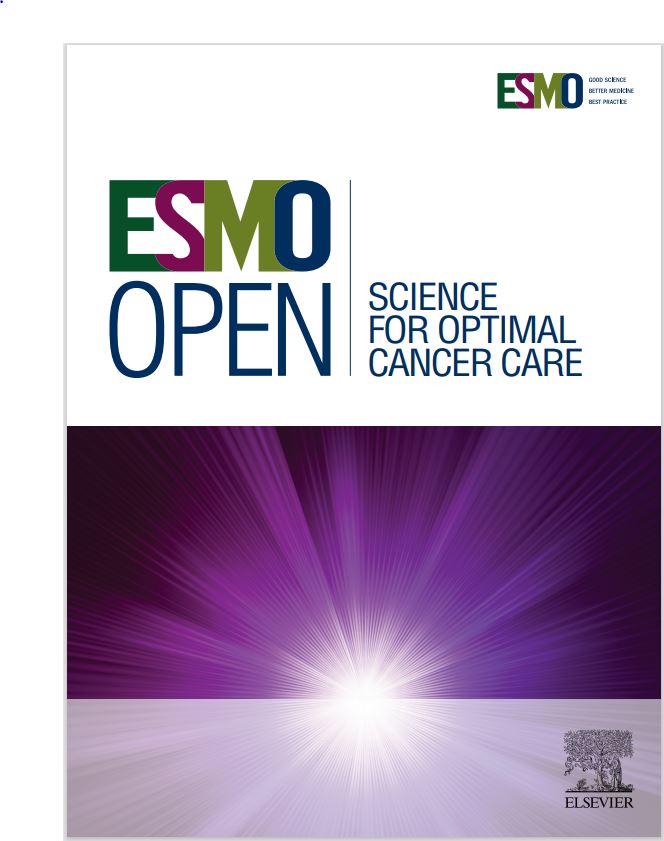RSC4All作为机器学习nomogram来预测RSClin™在HR+/HER2-淋巴结阴性早期乳腺癌中的疗效。
IF 8.3
2区 医学
Q1 ONCOLOGY
引用次数: 0
摘要
背景:RSClin™结合临床病理学(CP)和基因组数据来完善淋巴结阴性(N0)激素受体(HR)阳性/人表皮生长因子受体2 (HER2)阴性早期乳腺癌(eBC)远处复发(DR)风险和化疗(CT)获益的预测。rsclintm在美国可用,但由于监管限制,在欧洲无法使用。我们开发并验证了RSC4All,这是一个机器学习(ML) nomogram重现RSClin™预测,并通过比较复发评分(RS)、RSClin™和RSC4All的DR风险和CT获益评估临床影响。材料和方法:我们回顾性地在三个欧洲中心(发展队列)用21基因RS和RSClin™估计鉴定了290例hr阳性/ her2阴性的eBC。ML模型在70%的队列中进行训练,并在30%的队列中进行内部验证,以重现rsclintm对DR风险和CT益处的估计。外部验证采用513例患者的独立队列。采用受试者工作特征曲线下面积(ROC AUC)(分类)和R2(回归)评估疗效。使用Cohen’s kappa和McNemar检验评估RSC4All和RSClin™的临床一致性,包括复制RS到RSClin™的再分类模式。在合并人群中比较RS和RSClin™分类,并探讨再分类的CP预测因子。结果:ML分类模型的DR风险和CT获益的ROC AUC均为0.99,表现优异,回归模型的R2分别为0.82和0.77。在外部验证中,RSC4All保持了较高的准确性(ROC AUC = 0.99; R2 = 0.82和0.76),与RSClin™(Cohen’s kappa = 0.87和0.84)的临床一致性几乎完美,94.1% (DR)和93.0% (CT)的病例将RS复制到RSClin™的再分类方向。在合并队列中,RSClin™重新分类了22.2%的DR风险(平衡上调/下调)和12.2%的CT获益(主要是升级),高分级、高Ki-67、低孕酮受体和更大的肿瘤大小预测了向上的重新分类。开发了一个供公众使用的网络工具(https://rsc4all.streamlit.app)。结论:RSC4All准确地再现了RSClin™预测和重新分类模式,在无法获得RSClin™的情况下提供了一个免费的替代方案。通过整合CP和基因组数据,它可以细化风险分层,并支持N0 hr阳性/ her2阴性eBC的辅助决策。独立队列的外部验证增强了其普遍性和临床适用性。本文章由计算机程序翻译,如有差异,请以英文原文为准。
RSC4All as a machine learning nomogram to predict RSClin™ results in HR+/HER2- node-negative early breast cancer
Background
RSClin™ combines clinicopathological (CP) and genomic data to refine predictions of distant recurrence (DR) risk and chemotherapy (CT) benefit in node-negative (N0) hormone receptor (HR)-positive/human epidermal growth factor receptor 2 (HER2)-negative early breast cancer (eBC). Available in the United States, RSClin™ is inaccessible in Europe due to regulatory constraints. We developed and validated RSC4All, a machine learning (ML) nomogram replicating RSClin™ predictions and evaluating clinical impact by comparing DR risk and CT benefit estimates across recurrence score (RS), RSClin™, and RSC4All.
Materials and methods
We retrospectively identified 290 HR-positive/HER2-negative eBC with both 21-gene RS and RSClin™ estimation at three European centers (development cohort). ML models were trained on 70% and internally validated on 30% of this cohort to reproduce RSClin™ estimates for DR risk and CT benefit. External validation used an independent cohort of 513 patients. Performance was assessed using receiver operating characteristic area under the curve (ROC AUC) (classification) and R2 (regression).
Clinical agreement between RSC4All and RSClin™ was evaluated using Cohen’s kappa and McNemar’s test, including replication of RS to RSClin™ reclassification patterns. RS and RSClin™ classifications were compared in the pooled population and CP predictors of reclassification were explored.
Results
ML classification models achieved excellent performance with ROC AUC 0.99 for both DR risk and CT benefit, while regression model had R2 = 0.82 and 0.77, respectively. In external validation, RSC4All maintained high accuracy (ROC AUC = 0.99; R2 = 0.82 and 0.76) with an almost perfect clinical agreement with RSClin™ (Cohen's kappa = 0.87 and 0.84) and replicated RS to RSClin™ reclassification direction in 94.1% (DR) and 93.0% (CT) of cases. In the pooled cohort, RSClin™ reclassified 22.2% of DR risk (balanced up/downgrades) and 12.2% for CT benefit (mostly upgrades), with high grade, high Ki-67, low progesterone receptor, and larger tumor size predicting upward reclassification. A web-based tool was developed for public access (https://rsc4all.streamlit.app).
Conclusions
RSC4All accurately reproduces RSClin™ predictions and reclassification patterns, providing a freely accessible alternative where RSClin™ is unavailable. By integrating CP and genomic data, it refines risk stratifications and supports adjuvant decisions in N0 HR-positive/HER2-negative eBC. External validation in an independent cohort strengthens its generalizability and clinical applicability.
求助全文
通过发布文献求助,成功后即可免费获取论文全文。
去求助
来源期刊

ESMO Open
Medicine-Oncology
CiteScore
11.70
自引率
2.70%
发文量
255
审稿时长
10 weeks
期刊介绍:
ESMO Open is the online-only, open access journal of the European Society for Medical Oncology (ESMO). It is a peer-reviewed publication dedicated to sharing high-quality medical research and educational materials from various fields of oncology. The journal specifically focuses on showcasing innovative clinical and translational cancer research.
ESMO Open aims to publish a wide range of research articles covering all aspects of oncology, including experimental studies, translational research, diagnostic advancements, and therapeutic approaches. The content of the journal includes original research articles, insightful reviews, thought-provoking editorials, and correspondence. Moreover, the journal warmly welcomes the submission of phase I trials and meta-analyses. It also showcases reviews from significant ESMO conferences and meetings, as well as publishes important position statements on behalf of ESMO.
Overall, ESMO Open offers a platform for scientists, clinicians, and researchers in the field of oncology to share their valuable insights and contribute to advancing the understanding and treatment of cancer. The journal serves as a source of up-to-date information and fosters collaboration within the oncology community.
 求助内容:
求助内容: 应助结果提醒方式:
应助结果提醒方式:


